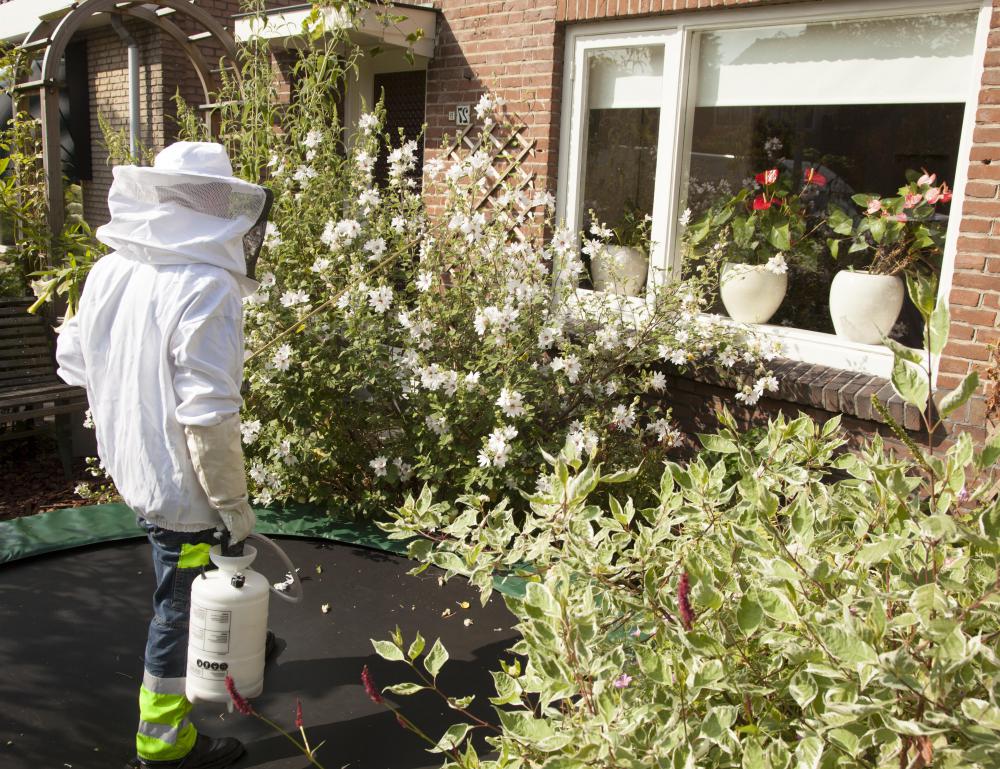At AllThingsNature, we're committed to delivering accurate, trustworthy information. Our expert-authored content is rigorously fact-checked and sourced from credible authorities. Discover how we uphold the highest standards in providing you with reliable knowledge.
What are Wood-Boring Beetles?
Wood-boring beetles are beetles that damage wood in homes. The damage can vary depending on the age of the home, the type of beetle and the environmental conditions. Homeowners use a variety of control methods to eradicate wood-boring beetles.
Adult wood-boring beetles lay their eggs on wooden surfaces. The eggs hatch into creamy-white grubs with dark-colored mandibles. The larvae burrow below the surface and feed on the wood, creating tunnels as they eat. After pupating and becoming adults, the beetles create exit holes to the outside. Once they have exited, they mate and begin the process all over again.

Several types of wood-boring beetles attack construction wood. Old house borer beetles, also known as long-horned beetles, prefer spruce, pine and hemlock. They have flattened brownish-black or black bodies and are 0.625-1.0 inches (16-25 mm) in length.
Powderpost beetles have elongated, dark-colored bodies and grow 0.125-0.25 inches (3-7 mm) long. Their larvae feed on hardwood species such as ash, walnut and oak, but they also enjoy bamboo. Powderpost beetles leave a dust-like or powdery mixture of insect excrement and sawdust inside galleries and outside exit holes.

False powderpost beetles have dark brown or black bodies and are 0.125-0.25 inches (3-7 mm), depending on the species. They attack species such as cherry, oak and walnut. Metallic wood-boring beetles have dark, shiny bodies and are 0.25-1.0 inches (7-25 mm) in length. They create vast networks of tunnels inside hardwood, softwood and unseasoned wood.
Deathwatch beetles are 0.125-0.25 inches (3-7 mm) long. They have reddish-brown or dark-brown bodies. They tap their heads against hard surfaces when they are trying to find mates. Deathwatch beetles prefer moisture levels of more than 14 percent.
Homeowners can prevent wood-boring beetle infestations by sealing wood with a protective coating of varnish or polyurethane. They can remove and replace individual boards or kill beetles that are in small wooden items by either freezing or heating the wood. They can also perform spot treatments with insecticides.
Severe or whole-house infestations usually require the services of a certified pest-control agent, who will fumigate the house for wood-boring beetles using substances such as sulfuryl fluoride. He or she might also be able to perform fumigations on individual items by placing them inside a specialized fumigation chamber. These services are expensive, however, and cannot guarantee that the beetles won't return.
Frequently Asked Questions
What are wood-boring beetles and why are they a concern?
Wood-boring beetles are a group of insects that lay their eggs in wood, where their larvae burrow and feed, causing structural damage. They are a concern because they can weaken wooden structures, including furniture, flooring, and even the wood within buildings, potentially leading to costly repairs or replacements.
How can I identify a wood-boring beetle infestation in my home?
Signs of an infestation include small holes in wood surfaces, fine powdery sawdust (frass), and sometimes the sound of larvae chewing within the wood. If you notice any of these symptoms, it's important to investigate further or consult a professional to assess the extent of the infestation.
What types of wood are most susceptible to wood-boring beetle infestations?
Wood-boring beetles often prefer damp and untreated wood. Softwoods like pine are particularly vulnerable, but hardwoods are not immune. Infestations are more likely in wood that has not been kiln-dried or treated with preservatives, as these processes can kill existing larvae and deter adult beetles.
Are wood-boring beetles harmful to humans or pets?
Wood-boring beetles are not directly harmful to humans or pets, as they do not bite or sting. However, their presence can lead to allergic reactions in some individuals due to the dust and frass they produce. Additionally, severely weakened structures can pose safety risks.
Can wood-boring beetles spread from one piece of furniture to another?
Yes, wood-boring beetles can spread from one infested item to another if the conditions are favorable for the beetles to thrive. Adult beetles can fly and lay eggs on nearby wood surfaces, perpetuating the cycle of infestation.
What are the best methods for preventing and treating wood-boring beetle infestations?
Prevention is key: use kiln-dried or chemically treated wood, maintain low humidity levels, and regularly inspect for signs of infestation. Treatment options include insecticidal treatments, fumigation, and replacing infested wood. For severe infestations, professional pest control services are recommended to ensure complete eradication.
AS FEATURED ON:
AS FEATURED ON:












Discuss this Article
Post your comments